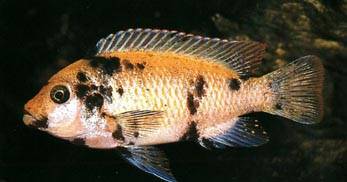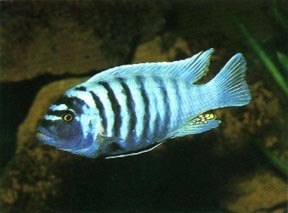Individual Fish Description Page


This page will give a completely detailed profile of the selected fish, from A to Z. The profiled fish will be chosen randomly by Badman, and will come from the complete
genre of tropical fish. I will try to update the profile on a monthly basis. If you have a specific fish you want profiled please vote for it in the favorite fish poll on the main index page. Please don't forget to let us know you experiences with this fish by filling out the form on the main profile page.


Photo from: "aquarium fish".
Pseudotropheus zebra
Overview:
The Zebra was one of the first Africans imported into the hobby. Its' striking colors, mating habits and different morphs have kept it one of the most popular fish from the great rift lakes.
Quick stats:
| size: | Up to 4.75 inches |
| tank: | 48 inches |
| strata: | Bottom, middle, top |
| pH: | 7.5 to 8.5 |
| Hardness: | hard to very hard |
| temperature: | 77o to 82o f |
Classification:
| Order: | Perciformes |
| Sub-order: | Percoidei |
| Family: | Cichlidae |
| Genera: | Pseudotropheus |
Common name:
Zebra, Cobalt blue Cichlid, Zebra Malawi Cichlid
Distribution:
Africa, lake Malawi. One of the Great rift lakes.
General Body Form:
Its forehead looks slightly swollen and they have the characteristic thick lips. Taller and more thick set than other members of its species. The soft rays of the anal and dorsal fin are pointed. The tail fin is slightly curved in (concave).

P. Zebra in its' home water.
Photo from: "Cichlids from Eastern Africa, A Tetra publication.
Coloration:
The coloration of the zebra can vary widely. Ranging from Blue to Albino morphs. This range of coloration is known as polychromatism. The most common morph is the Blue variety, other include the checkered varieties known as the Orange Blotch Morph (OB-morph), the light Blue Morph and the White Morph. The Blue variety has a pale Blue background with seven or eight Blue-Black bars on the body. The first two bars bend toward the front of the fish. The soft rayed part of the Anal fin has four Orange egg spots. The rear edge of the Dorsal fin has a row of less distinct spots as well.
The OB-Morph has a light Yellow background with many Black blotches of different shapes and sizes placed randomly across the body. This morph consists mostly of females and a male OB is very rare. The males have a Bluish sheen, which becomes very distinct at breeding time.
The other Morphs are less common and there is some thought that they may be a closely related but separate species.

OB-Morph form.
photo from "Cichlids from Eastern Africa, A Tetra publication"
Maintenance:
Keeping the Zebras is not difficult as long as certain requirements are met. They should be kept in a large community aquarium with other Mbuna type fish like the species from the Labeotropheus, Melanochromis as well as others from the Pseudotropheus Genus. The minimum length of the tank should be four feet. The aquarium should try to mimic the natural rubble zone where they live. This includes extensive rockwork with caves and other hiding places that kind of divide the tank into different territories. Plants are not needed and will be constantly dug up by the fish. As noted from the stats above these fish prefer a hark alkaline water with a fairly high pH. I have maintained this by using a mixture of crushed coral as a substrate. Feeding is not a problem as all types of food are taken, weather flake or frozen, it should contain a high content of plant material. live food like earthworms and the such should be offered only occasionally as they are low in fibers and not the best choice.
Biotope:
Rocky regions of the lake free of sediment..

Otter point, Lake Malawi.
photo from "Cichlids from Eastern Africa, A Tetra publication"
Breeding:
Breeding of the fish from the Rift Lakes is one of the most fascinating things a hobbyist can observe. They are known as mouthbrooders. No bonding takes place between the male and females of the species and unlike their South American cousins one female will not be enough for the male. You should have at least a ratio of three females to each male in the tank. Right after the spawning males and females go their own ways and only the mother will care for the eggs and fry. The preferred spawning site is a flat stone in a covered secluded place. The eggs are still unfertilized when the female takes them in her mouth. They are fertilized when the female follows the male with her mouth close to his anal fin. The egg spots play an important role as it is thought that the female believes these are more eggs and goes to retrieve them. At this moment the male releases his sperm and fertilizes the eggs in her mouth. The eggs are rich with yolk and take a long time to hatch. Once hatched the yolk sac takes about 20 days to be absorbed. Due to their larger size the fry can be fed finely crushed flake food or even Daphnia if you can find it. If raised in a community setting special feeding should not be needed as the fry will be able to find small left over food particles floating in the tank. One of the best things to observe is the fry retreating back into the mothers mouth when danger nears.



back to the fish profile page.

Email:
badman2nd@hotmail.com








